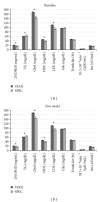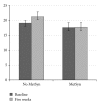Macronutrient intake influences the effect of 25-hydroxy-vitamin d status on metabolic syndrome outcomes in african american girls
- PMID: 22792449
- PMCID: PMC3389646
- DOI: 10.1155/2012/581432
Macronutrient intake influences the effect of 25-hydroxy-vitamin d status on metabolic syndrome outcomes in african american girls
Abstract
The objectives were to determine the effect of macronutrient modification on vitamin D status and if change in 25-hydroxy-vitamin D concentration influences components of metabolic syndrome in obese African American girls. Methods. Five-week intervention using reduced CHO (43% carbohydrate; 27% fat: SPEC) versus standard CHO (55% carbohydrate; 40% fat: STAN) eucaloric diet. Subjects were 28 obese African American females, aged 9-14 years. Dual energy X-ray absorptiometry and meal test were performed at baseline and five weeks. Results. Approximately 30% of girls had metabolic syndrome. Serum 25OHD increased in both groups at five weeks [STAN: 20.3 ± 1.1 to 22.4 ± 1.1 (P < 0.05) versus SPEC: 16.1 ± 1.0 to 16.8 ± 1.0 (P = 0.05)]. The STAN group, increased 25OHD concentration over five weeks (P < 0.05), which was positively related to triglycerides (P < 0.001) and inversely associated with total cholesterol (P < 0.001) and LDL (P < 0.001). The SPEC group, had increase in 25OHD (P = 0.05), which was positively related to fasting insulin (P < 0.001) and insulin sensitivity while inversely associated with fasting glucose (P < 0.05). The contribution of vitamin D status to metabolic syndrome parameters differs according to macronutrient intake. Improvement in 25OHD may improve fasting glucose, insulin sensitivity, and LDL; however, macronutrient intake warrants consideration.
Figures



Similar articles
-
Reduced carbohydrate diet to improve metabolic outcomes and decrease adiposity in obese peripubertal African American girls.J Pediatr Gastroenterol Nutr. 2012 Mar;54(3):336-42. doi: 10.1097/MPG.0b013e31823df207. J Pediatr Gastroenterol Nutr. 2012. PMID: 22067112 Free PMC article. Clinical Trial.
-
Vitamin D3 supplementation in obese, African-American, vitamin D deficient adolescents.J Clin Transl Endocrinol. 2018 Mar 21;12:1-7. doi: 10.1016/j.jcte.2018.03.001. eCollection 2018 Jun. J Clin Transl Endocrinol. 2018. PMID: 29892560 Free PMC article.
-
Associations of serum 25-hydroxyvitamin D and components of the metabolic syndrome in obese adolescent females.Obesity (Silver Spring). 2011 Nov;19(11):2214-21. doi: 10.1038/oby.2011.110. Epub 2011 May 5. Obesity (Silver Spring). 2011. PMID: 21546933 Free PMC article.
-
The effect of vitamin D supplementation on serum 25(OH)D in thin and obese women.J Steroid Biochem Mol Biol. 2013 Jul;136:195-200. doi: 10.1016/j.jsbmb.2012.12.003. Epub 2012 Dec 11. J Steroid Biochem Mol Biol. 2013. PMID: 23246640 Free PMC article. Review.
-
Effects of macronutrient intake in obesity: a meta-analysis of low-carbohydrate and low-fat diets on markers of the metabolic syndrome.Nutr Rev. 2021 Mar 9;79(4):429-444. doi: 10.1093/nutrit/nuaa044. Nutr Rev. 2021. PMID: 32885229 Free PMC article. Review.
Cited by
-
Anorexia Nervosa and Bone.Curr Opin Endocr Metab Res. 2018 Dec;3:74-82. doi: 10.1016/j.coemr.2018.01.002. Epub 2018 Jan 31. Curr Opin Endocr Metab Res. 2018. PMID: 31803857 Free PMC article.
-
Interaction between Vitamin D-Related Genetic Risk Score and Carbohydrate Intake on Body Fat Composition: A Study in Southeast Asian Minangkabau Women.Nutrients. 2021 Jan 23;13(2):326. doi: 10.3390/nu13020326. Nutrients. 2021. PMID: 33498618 Free PMC article.
-
Higher Dietary Vitamin D Intake Influences the Lipid Profile and hs-CRP Concentrations: Cross-Sectional Assessment Based on The National Health and Nutrition Examination Survey.Life (Basel). 2023 Feb 19;13(2):581. doi: 10.3390/life13020581. Life (Basel). 2023. PMID: 36836938 Free PMC article.
-
A Nutrigenetic Approach to Investigate the Relationship between Metabolic Traits and Vitamin D Status in an Asian Indian Population.Nutrients. 2020 May 9;12(5):1357. doi: 10.3390/nu12051357. Nutrients. 2020. PMID: 32397403 Free PMC article.
References
-
- Al-Musharaf S, Al-Othman A, Al-Daghri NM, et al. Vitamin D deficiency and calcium intake in reference to increased body mass index in children and adolescents. European Journal of Pediatrics. In press. - PubMed
Grants and funding
LinkOut - more resources
Full Text Sources
